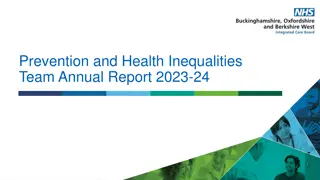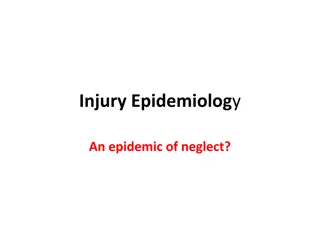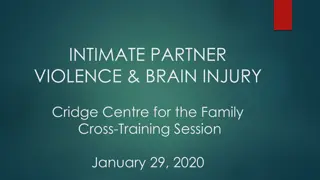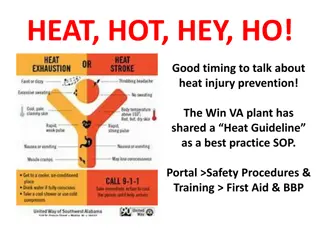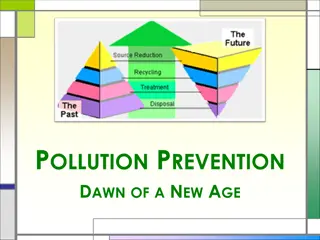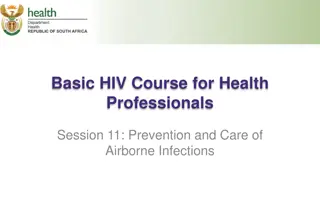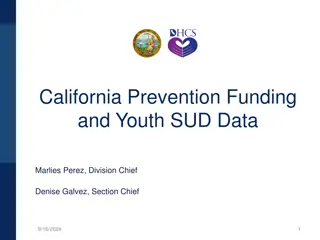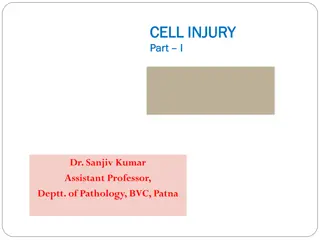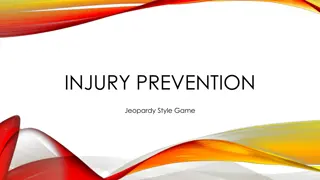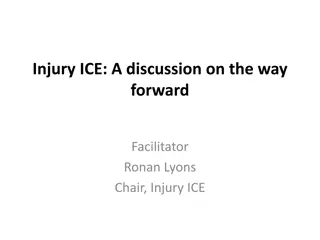Injury Prevention: Where to From Here?
One way countries' human rights status is judged is by how labor is treated. New Zealand's unique compensation scheme based on community responsibility, comprehensive entitlement, complete rehabilitation, and administrative efficiency addresses occupational injury challenges. The presentation explores the lack of data evaluation, enforcement commitment, and emerging issues in workplace safety.
Download Presentation

Please find below an Image/Link to download the presentation.
The content on the website is provided AS IS for your information and personal use only. It may not be sold, licensed, or shared on other websites without obtaining consent from the author.If you encounter any issues during the download, it is possible that the publisher has removed the file from their server.
You are allowed to download the files provided on this website for personal or commercial use, subject to the condition that they are used lawfully. All files are the property of their respective owners.
The content on the website is provided AS IS for your information and personal use only. It may not be sold, licensed, or shared on other websites without obtaining consent from the author.
E N D
Presentation Transcript
Injury Prevention: Where to from here? Felicity Lamm http://ohsnet.org.nz/
Introduction One way in which countries can be judged as to their level of sophistication over human rights is the way in which labour is treated & afforded state protection. The barometer of the country s human rights status can be measured in terms of the: The robustness of both OHS legislation & the enforcement agency The level of occupational injuries & illnesses. Aotearoa NZ is also a good case study as it has a long tradition of introducing radical social, economic, & employment policies, in which ACC is an excellent example. Given that we have adopted similar OHS legislation, why do we have a worse rate of occupational injury compared to the UK, Australia, etc? What are our values?
NZs Unique Compensation Scheme In 1967, a Royal Commission, chaired by the Hon. Owen Woodhouse investigated compensation for personal injury & proposed a universal no-fault system based on 5 guiding principles: 1.Community responsibility: the community must protect all citizens as it is in nation s interests. 2.Comprehensive entitlement: All those injured should receive compensation regardless of the causes
NZs Unique Compensation Scheme 3. Complete rehabilitation: The scheme must provide physical & vocational recovery for all its citizens & providing a fair monetary compensation for their losses Real compensation for the whole period of incapacity 5. Administrative efficiency :There should be no delays or inconsistencies (Royal Commission to Inquire into & Report upon Workers Compensation, 1967: 39). 4.
Overview of Presentation Informed by: Pike River Coal Mine Disaster Christchurch Earthquake (CTV building, etc) NOHSAC Technical Report 12 (2009) Independent Health & Safety Taskforce (extended the spirit of the Taskforce & invited comments) The perennial issues: Lack of reliable data Lack of evaluation Lack of effective enforcement Lack of commitment Emerging Issues: Changing workforce & nature of work Changing nature of employment Changing nature of compensation
Injury Prevention Initiatives The main drivers for ACC-initiated programmes are: Cost of ACC compensation claims & Number of claims The focus is on hazardous industries: Targeted interventions, eg, FishSafe & FarmSafe. Public &/or political pressure, for example: submissions in response to government inquiries/hearings or; as a result of trends perceived to be socially unacceptable, eg a rise in a particular chemically-induced illness Most of NZ s OHS research & preventative initiatives were funded by ACC, Health Research Council, DoL & NOHSAC, but there is little current funding
Government Expenditure on Workplace Injury Prevention ($ million) 100 Government Expenditure ($ million) 90 80 70 60 50 40 30 20 10 0 2003-2004 2005-2006 2008 2009 2009 2010 2010-2011 2012- Year
Number of Levy invoices by year 120000 100000 Number of invoices 80000 60000 40000 20000 0 2001 2002 2003 2004 2005 2006 Year
Number of Levy invoices by year 120000 100000 Number of Invoices 80000 60000 40000 20000 0 2001 2002 2003 2004 2005 2006 Levy year
Perennial issues: Lack of reliable data We still have no idea of the extent of the injuries, illnesses & fatalities in NZ There is no coherent data collection strategy nor is there any compulsion to standardize the data Problems with under-reporting & subjected to manipulation. Also data surveillance systems rarely capture occupational injury & illness data of precariously employed workers
Perennial issues: Lack of reliable data Lumping different industries together, (eg agriculture, forestry & fishing), some of which have the highest fatality rates in NZ & include a large proportion of SMEs, makes industry analysis problematic Efforts to improve the situation have been thwarted, for example: Disestablishment of NOHSAC & Injury Surveillance Ministerial Advisory Panel [ISMAP]) Lack of on-going funding in the area of injury (& disease) surveillance & prevention
Perennial issues: Lack of rigorous evidence What is not clear is whether or not injury prevention initiatives actually fit the purpose for which they were designed? And whether or not national & regional differences have been taken into consideration? Many of the NZ injury prevention initiatives have been influenced by overseas models. However, what is not clear is whether overseas models are an appropriate fit in NZ?
Perennial issues: Lack of rigorous evidence Although there is a plethora of injury prevention initiatives, there has been little scrutiny of the efficacy of such programmes & few publically available reports. As Shannon et al. (1999) note: many interventions in occupational safety are implemented with the sincere hope that they will work, but with a lack of solid evidence of their effectiveness [and] can sometimes make the situation worse (p.161). See NOHSAC Technical Report, Number 12,
Perennial issues: Lack of rigorous NZ evidence There have been few evaluations of NZ injury prevention initiatives. Instead there is a reliance on subsequent injury data to become the de facto measure of the success or failure of the prevention initiative. Most injury prevention initiatives were designed around specific workplace hazards & thus the focus of the evaluation (if indeed there ever was one) has been on the success or failure of injury reduction & less (if at all) on the uptake of the initiative by the business community. An evaluation on an injury prevention initiative is typically carried out or controlled by those with a vested interest in its success.
Perennial issues: The lack of sustainability While there was often an initial flurry of activity to establish a particular injury prevention initiative, in most cases it was difficult to sustain. One of the main reasons for an injury prevention initiative to falter was that once key protagonists were no longer involved & suitable replacements were not found, it became difficult to sustain, eg ACC/DoL/Waitakere City Council Cleaner Boat Production Project. Regular reviews of the injury initiative is a way of ensuring that there is continual commitment from all parties.
Perennial issues: Lack of effective enforcement Since 1988 the Department of Labour has undergone major restructuring & successive governments have to a greater or lesser degree rolled back the state . The DoL was directed to focus exclusively on core labour market functions while taking a side-line/advisory position to most aspects of employment, including frontline enforcement. This has also resulted in limited content knowledge of OHS amongst civil servants responsible for this area & a high turn- over in staff (restructuring & poor paid) There has often been a need for better integration between the various government agencies when tackling OHS & stronger community links (but might change with Better Public Services programme)
Number of OHS inspectors by number enterprises 1988 1998 2008 No. of OHS inspectors 317 168 130 Size of Business Population 247,143 471,100 470,050
Lack of effective enforcement (cont) The reasons for the reduced coverage of inspectors are threefold: There has been a systematic withholding of resources to the OHS inspectorate since the 1980s In theory self-regulation requires fewer inspectors as the onus is on the employer (& to a lesser extent the employee) to ensure a healthy & safe workplace. There was a trade-off employers involvement in setting standards & DoL would back off. BUT there is either a lack of willingness (or a lack of competency) on the part of employers to engage in OHS infrastructure eg Minex OHS Mining reference group set up to develop performance standards & codes of practice but nothing or very little eventuated. 1. 2. 3.
Lack of effective enforcement (cont) The NZ Department of Labour was disestablished on the 1st July 2012 & merged into a mega agency called the Ministry of Business, Innovation & Employment Government press releases also reinforce the business focus of the Ministry, for example: The establishment of a new business-facing department to take more effective leadership of NZ s microeconomic policy agenda & the development of practical decisions to achieve productivity improvement & competitive, internationally-focused businesses & industries . Overwhelming tripartite support for a stand-alone OSH Ministry, that incorporates all accident investigation responsibilities (eg Transport Accident Investigation Commission, etc).
Perennial issues: Lack of commitment The disestablishment of the Department of Labour also raises uncomfortable questions: 1. Is the demise of the Department of Labour indicative of its lack of political influence & employer patronage combined with the lack of influence of workers? 2. Given its new form, is MoBIE capable of protecting the OHS of workers? Both questions are difficult to answer
Emerging Issues: Changing work Demographics: Aging workforce: Those aged 75 & over now make up 5.5 % of the total population Immigration: managing OHS in diverse settings is topical. Increasingly diverse workforce eg Auckland CBD approx over 70% are non-European & possible changes to the demographics in Christchurch Work: the introduction of new technology (eg mining); the emergence of more flexible forms of work & organisations; the ongoing intensification of work operating within complex systems, for example: supply chains/sub-contracting, satellite divisions eg Aust/NZ.
Emerging Issues: Changes in Employment Employment Rise in the number of non-standard & precariously employed workers, 90-Day Trial Period: high % of injuries occur within the first 90 days of work & will it be difficult to raise a claim? Industries are under increasing pressure tighter margins (trucking & fishing industries) & increased local & international competition, Lack of skilled workers (eg engineering = lowering of OHS standards?)
Emerging Issues: Compensation Compensation: The debates around what, how & who should be compensated will become more intense Experience rating will impact how we set levies & manage claims (earners vs work accounts = tension between employers & employees) To privatise or not?: Another layer of complexity on business? Merging compensation with enforcement? Two competing views So what happens to the injured & what impact does it have on family & community? Migrants (RSE workers?), older workers? And what impact will the growing disparities between rich & poor have on obtaining workers compensation? Spirit Level by Richard Wilkinson & Kate Pickett
A Way Forward Perennial issues If we know what causes injuries, why do they still occur? have to be addressed, commencing with understanding the extent of the problem. Separate, robust OHS agency & ACC Emerging issues: Strategic plans need to include dialogue with all key players, recognising regional differences, different business sizes, etc; Should not ignore sunrise industries (focus is typically on sunset industries) Revisit Woodhouse principles: including administrative efficiency
A Way Forward Key Ingredients of OHS initiatives: Treat injury prevention fads that based often with manufacturing, with caution but we can learn from other disciplines, eg traffic safety Tripartite, industry, & community involvement & commitment the success of Queensland building industry s injury prevention initiative Capacity & capability building within sectors necessary to ensure that the OHS initiatives will have an impact on the target group. Champions & mentors: worked well in hard to crack industries Continuity & succession: There has to be succession planning when introducing any OHS initiatives Evaluations are essential
THANK YOU http://ohsnet.org.nz/







